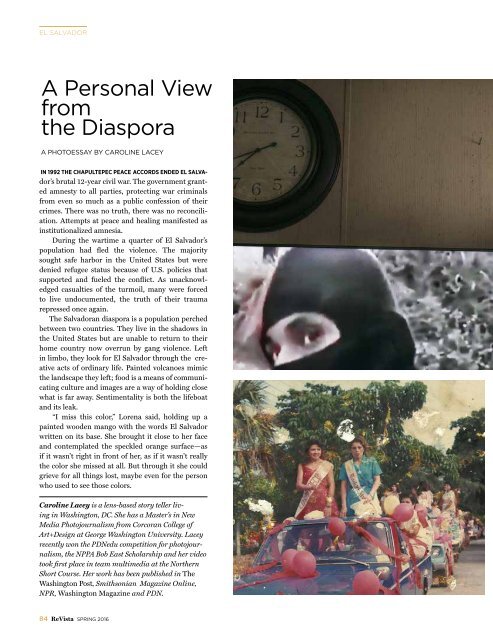EL SALVADOR
8clowSgZh
8clowSgZh
Create successful ePaper yourself
Turn your PDF publications into a flip-book with our unique Google optimized e-Paper software.
<strong>EL</strong> <strong>SALVADOR</strong><br />
A Personal View<br />
from<br />
the Diaspora<br />
A PHOTOESSAY BY CAROLINE LACEY<br />
IN 1992 THE CHAPULTEPEC PEACE ACCORDS ENDED <strong>EL</strong> SALVAdor’s<br />
brutal 12-year civil war. The government granted<br />
amnesty to all parties, protecting war criminals<br />
from even so much as a public confession of their<br />
crimes. There was no truth, there was no reconciliation.<br />
Attempts at peace and healing manifested as<br />
institutionalized amnesia.<br />
During the wartime a quarter of El Salvador’s<br />
population had fled the violence. The majority<br />
sought safe harbor in the United States but were<br />
denied refugee status because of U.S. policies that<br />
supported and fueled the conflict. As unacknowledged<br />
casualties of the turmoil, many were forced<br />
to live undocumented, the truth of their trauma<br />
repressed once again.<br />
The Salvadoran diaspora is a population perched<br />
between two countries. They live in the shadows in<br />
the United States but are unable to return to their<br />
home country now overrun by gang violence. Left<br />
in limbo, they look for El Salvador through the creative<br />
acts of ordinary life. Painted volcanoes mimic<br />
the landscape they left; food is a means of communicating<br />
culture and images are a way of holding close<br />
what is far away. Sentimentality is both the lifeboat<br />
and its leak.<br />
“I miss this color,” Lorena said, holding up a<br />
painted wooden mango with the words El Salvador<br />
written on its base. She brought it close to her face<br />
and contemplated the speckled orange surface—as<br />
if it wasn’t right in front of her, as if it wasn’t really<br />
the color she missed at all. But through it she could<br />
grieve for all things lost, maybe even for the person<br />
who used to see those colors.<br />
Caroline Lacey is a lens-based story teller living<br />
in Washington, DC. She has a Master’s in New<br />
Media Photojournalism from Corcoran College of<br />
Art+Design at George Washington University. Lacey<br />
recently won the PDNedu competition for photojournalism,<br />
the NPPA Bob East Scholarship and her video<br />
took first place in team multimedia at the Northern<br />
Short Course. Her work has been published in The<br />
Washington Post, Smithsonian Magazine Online,<br />
NPR, Washington Magazine and PDN.<br />
84 ReVista SPRING 2016


